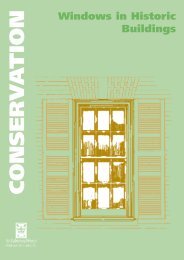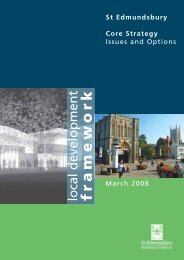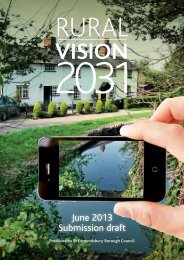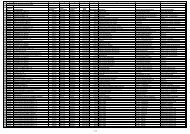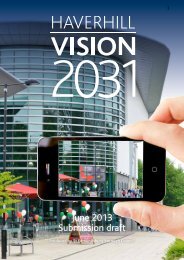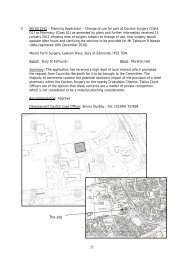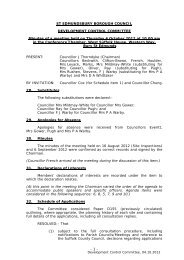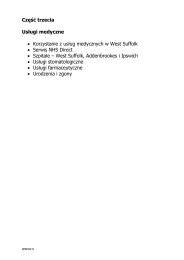St Edmundsbury Core Strategy (December 2010)
St Edmundsbury Core Strategy (December 2010)
St Edmundsbury Core Strategy (December 2010)
You also want an ePaper? Increase the reach of your titles
YUMPU automatically turns print PDFs into web optimized ePapers that Google loves.
Development to the western edge of the town beyond Hanchett End to thenorth and south of the A1307;Development to the northern edge of the town beyond the area recentlydeveloped at Withersfield Road;Development to the north-eastern edge beyond Samuel Ward Upper Schooland Chalkstone Way; orA combination of these approaches6.10 Each of these options was considered against a range of sustainabilitycriteria including the provision, availability and potential to deliver different levelsof infrastructure, its potential impact on the environment and its ability tointegrate fully with the existing urban fabric and bring benefits (<strong>Core</strong> <strong>St</strong>rategySubmission Sustainability Appraisal). As part of the evaluation process theBorough Council also worked with a range of stakeholders to assess the impactand deliverability of infrastructure to meet the community‟s needs and produced anumber of evidence based studies, including the Infrastructure and EnvironmentalCapacity Appraisal, which helped inform our selection of a suitable area fordevelopment.6.11 This evaluation confirmed that a critical mass is required to deliver essentialinfrastructure requirements such as schools and health care facilities. These wouldnot be delivered by adopting a combination approach.6.12 As the Infrastructure and Environmental Capacity Appraisal confirmed,development of the western edge of the town would be least likely to integratewith the existing urban fabric, being the most remote from the town centre andwould be most likely to encourage out commuting to Cambridge. Furthermore,although the low lying area has minimal environmental impact, parts are subjectto risk from flooding. The area is also poorly located for foul water disposal beinglocated at the furthest point from the waste treatment works, likely to overburdenthe existing sewerage network including the town centre.6.13 The northern edge is less remote from the centre than the western edge,but it would be the most likely to have a significant environmental impact, beingthe closest point to the adjacent village of Withersfield and likely to conflict withPolicy CS4 which seeks to protect settlement identity.6.14 The results of the background work to the <strong>Core</strong> <strong>St</strong>rategy concluded that themost appropriate location for the future growth of the town was the landextending beyond Samuel Ward Upper School and Chalkstone Way forming thenorth-eastern edge to Haverhill. This location is well positioned to accommodatefuture long term strategic growth for the town and create sustainable communitiesfollowing the completion of the strategic site to the North West. The area is welllocated for integration with the existing pattern of development with foot andcycle links to the town centre and employment areas.6.15 Careful planning will be required to ensure that the ridge creating the visualboundary with Kedington is not breached and the Scheduled Ancient Monument atWilsey Farm is protected.6.16 The release of land in this area will bring considerable community gainthrough the provision of open space and community facilities.6.17 The strategy for growth will provide for at least 2,500 new homes inHaverhill by 2031, over and above those that are already identified in the LocalPlan and are being rolled forward or are being built at the moment. However, this70




